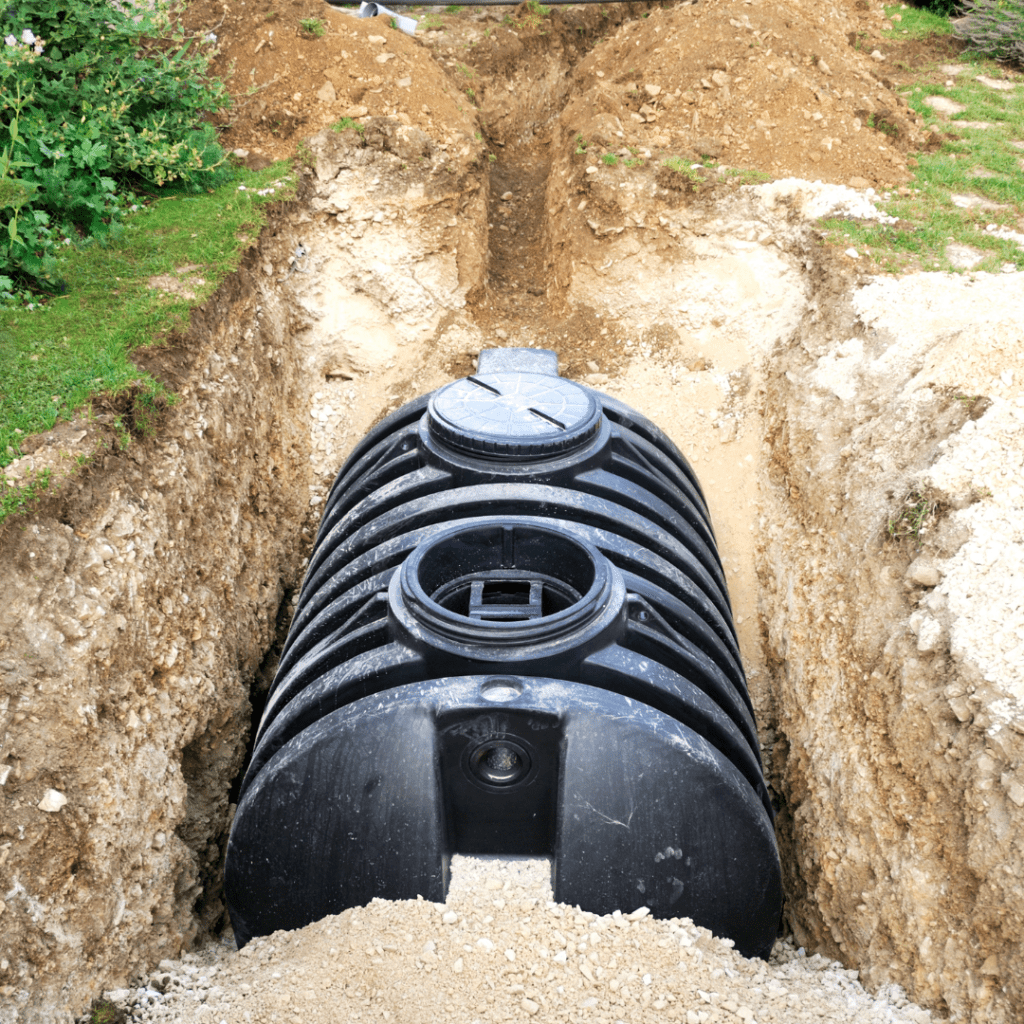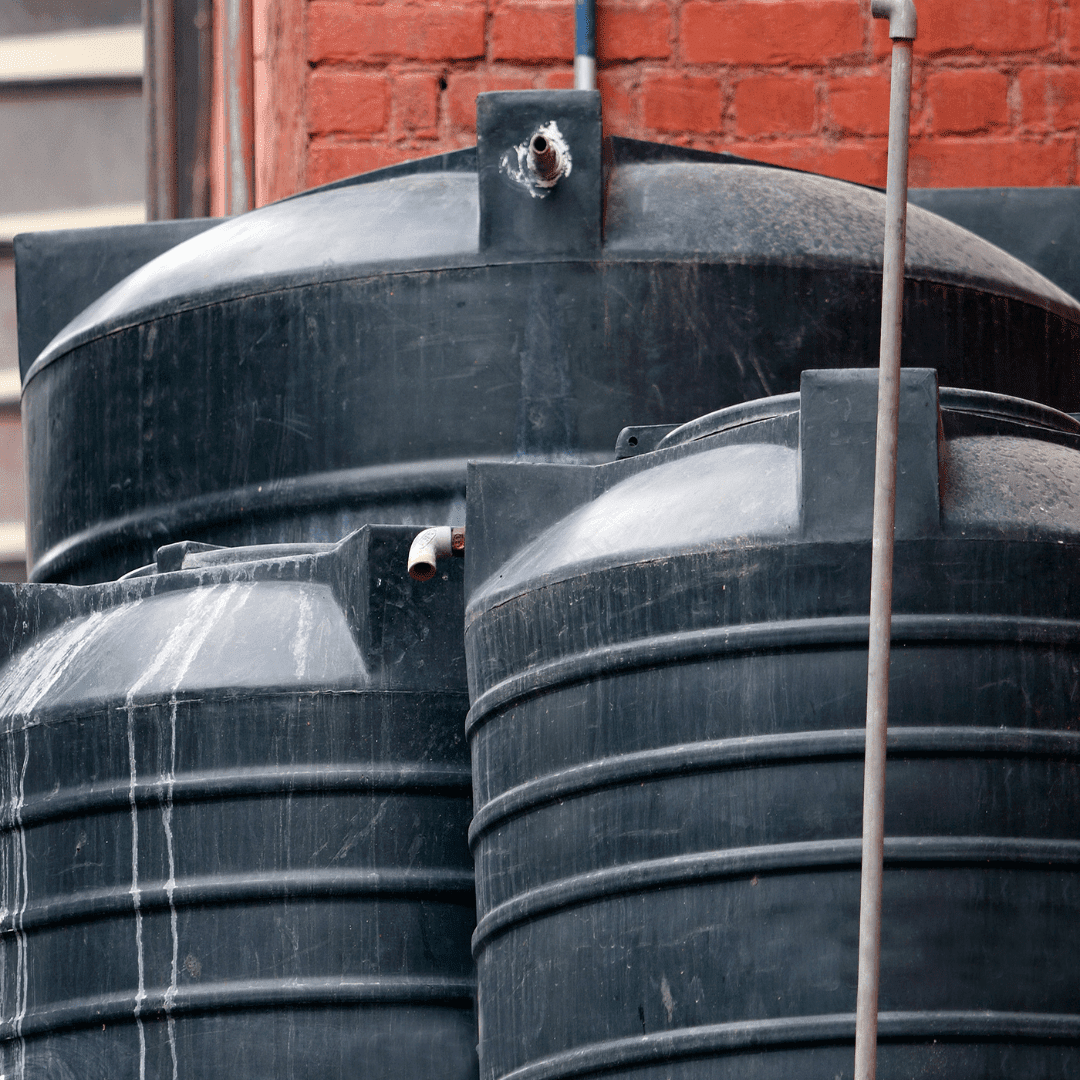Want to save water and live more sustainably? See how greywater tanks can turn everyday water waste into a resource for your home and garden!
Water is way too precious to just send down the drain, especially when you live off-grid. That’s where greywater tanks come in handy—they catch water from your sinks, showers, and laundry and give it a second life, watering your garden or other non-drinking uses. In this post, I’m going to share how greywater tanks work, why they’re a game-changer for sustainability, and how you can start using them at home without any complicated setups.
This is a pinnable post. Tap or hover over any image in this post to pin to your Pinterest Boards.

Introduction to Greywater Tanks
Brief Overview of the Concept of Greywater Tanks
As your guide on this green journey, I’m here to provide you with a friendly and informative overview of what greywater tanks are all about. Think about this for a moment: you’re going about your daily routine, washing dishes, doing laundry, maybe even taking a refreshing shower. Now, instead of letting all that water disappear down the drain, imagine capturing it in a tank and giving it a second life in your garden! That’s the magic of greywater tanks!
With a bit of filtration and treatment, you can turn your household wastewater into a valuable resource for watering plants, flushing toilets, and so much more. So, if you’re curious about how to harness the power of greywater for a more sustainable lifestyle, you’ve come to the right place!
Exploring the Role of Greywater Tanks In Sustainable Living
As your enthusiastic guide on this green adventure, I’m here to shed some light on how these ingenious tanks can make a real difference in our efforts to live more harmoniously with the planet.
Imagine being able to transform your everyday household activities, like showering or doing laundry, into opportunities to conserve water and nourish your garden, as previously mentioned. With the help of greywater tanks, this dream can become a reality!
I’m passionate about sharing practical tips and insights to help you harness the power of greywater in your own sustainable living journey. So, if you’re ready to dive deep into the world of eco-friendly solutions and make a positive impact on the environment, let’s get started! Together, we’ll uncover the secrets of sustainable living with greywater tanks as our trusty companions in our homes.
Understanding Greywater
Definition of Greywater and Its Distinction from Blackwater
Let’s kick off our exploration of greywater with a friendly chat about what exactly it is and why it’s different from blackwater. Think about all that water you’re using for your daily showers, dishwashing, and laundering. That’s greywater that you are using! It’s the gently used stuff from your household activities, excluding toilets.
Now, here’s the crucial distinction: blackwater, on the other hand, includes wastewater from toilets and can contain pathogens and other nasties. But don’t worry! Greywater is much cleaner and can be safely reused with a little treatment.
So, if you’re ready to learn more about the fascinating world of greywater and how it can revolutionize your sustainability efforts, stick around! I’m here to guide you every step of the way with friendly advice and helpful insights. Together, we’ll unravel the mysteries of greywater and take our eco-conscious living to the next level, and see for ourselves what this hype is all about!
Sources of Greywater In Households
From the shower where we wash away the day’s grime to the kitchen sink where we scrub our dishes squeaky clean, there’s a treasure trove of greywater waiting to be reclaimed for a noble cause. But it doesn’t stop there!
Think about the laundry room, where we freshen up our clothes and linens, or even the bathroom sink where we brush our pearly whites. Yep, you guessed it—all potential sources of greywater!
I’m here to help you identify these sources and harness their potential for good. So, if you are ready to implement more sustainable practices in your life and are just getting into the world of eco-friendly living, I’ve got your back.
Here are some common sources of greywater in households:
- Bathroom sinks.
- Showers.
- Bathtubs.
- Washing machines.
- Dishwashers.
- Kitchen sinks.
- Utility sinks (e.g., laundry sinks).
- Handwashing stations.
Common Contaminants In Greywater
When we’re talking about reusing water from our homes, it’s essential to understand what we’re dealing with. Think about all the products we use on a daily basis—shampoos, soaps, detergents, and cleaning agents.
While these help us stay squeaky clean, they can also introduce contaminants into our greywater. But with a little knowledge and the right strategies, we can tackle these contaminants head-on!
From choosing eco-friendly products to implementing effective filtration systems, we can ensure that our greywater is as clean and safe as possible for reuse.
Here are some common household contaminants found in greywater:
- Soap and shampoo residues.
- Dirt and debris.
- Food particles.
- Laundry detergent.
- Cleaning agents.
- Grease and oils.
- Hair and skin cells.
- Organic matter.
- Bacteria and pathogens (if not properly treated).
- Chemical pollutants (depending on household activities).
Mitigating Greywater Contaminants
As we strive to make the most of our precious water resources, it’s crucial to address any potential pollutants that may lurk in our greywater. From biodegradable soaps to natural cleaning products, there are plenty of ways to minimize the impact of contaminants on our greywater supply.
With a little bit of know-how and a whole lot of passion for sustainability, we can make a big difference! So take a peek at what the market has available when it comes to shopping for sustainable and eco-friendly personal and household products we use daily.
Psst! I have already taken a peek at what’s on the market and found some amazing sustainable household and personal products we can use! I even created a whole page dedicated to these products because they are that awesome! Check it out!
Sustainable Household and Personal Products
The Environmental Impact of Greywater

Discussion on Water Scarcity and the Importance of Conserving Water Resources
Water scarcity and the urgent need to conserve our precious water resources is near and dear to my heart. As we navigate the challenges of a rapidly changing world, it’s becoming increasingly clear that water is one of our most valuable assets—and it’s in danger!
From drought-stricken regions to dwindling freshwater supplies, the signs of water scarcity are all around us. True as this may be, however, we can make a difference. By embracing simple yet effective water conservation strategies, like installing greywater tanks and practicing mindful water usage, we can help ensure a brighter, more sustainable future for future generations.
Comparison of Greywater Recycling vs. Traditional Wastewater Disposal Methods
When it comes to conserving water and reducing our environmental impact, the choice between these two approaches can make a world of difference. On one hand, we have traditional wastewater disposal methods, which involve sending all our household water down the drain, where it’s treated and then released back into the environment.
On the other hand, we have greywater recycling, which allows us to capture and reuse that water for beneficial purposes like watering our gardens or flushing toilets.
I’m here to provide you with all the information you need to make an informed decision. Together, we’ll explore how greywater recycling can help us conserve water, reduce pollution, and create a more sustainable future. Now, let’s discover some environmental benefits of using greywater tanks.
Environmental Benefits of Using Greywater for Irrigation and Toilet Flushing
When we recycle our household water for these purposes, we’re not just saving money on our water bills—we’re also making a positive impact on the planet. Instead of relying solely on freshwater sources for our gardens and toilets, we can repurpose the greywater we generate every day to nourish our plants and flush away waste.
This not only conserves water but also reduces the strain on our local water supplies and wastewater treatment systems.
Benefits of Greywater Tanks
Reduction In Water Consumption and Utility Bills
By capturing and reusing water from everyday activities like showering and laundry in greywater tanks, we’re not just being environmentally friendly—we’re also saving money! Just imagine the satisfaction of seeing your water bill decrease month after month, all while knowing you’re doing your part to conserve this precious resource.
We can have the satisfaction of saving water, saving money, and making a positive impact on the planet all at the same time!
Contribution to Water Conservation Efforts
By repurposing water from everyday activities like washing dishes and taking showers, we’re not just cutting down on our water bills—we’re also doing our part to preserve this precious resource for future generations.
Just imagine the impact we can make by collectively reducing our water usage and lessening the strain on our planet’s water supplies. That alone is enough to help us feel good about this sustainable practice!
Potential for Reducing Strain on Municipal Wastewater Treatment Systems
Let’s talk about an often-overlooked benefit of using greywater tanks: reducing strain on municipal wastewater treatment systems. By recycling water from activities like laundry and dishwashing, as discussed, we’re lightening the load on these vital systems, which can become overwhelmed during peak usage times.
Just imagine the positive ripple effect of fewer pollutants entering our waterways and less energy needed for treatment!
Promotion of Sustainable Gardening Practices
Let’s get right into one of the most exciting benefits of using greywater tanks: promoting sustainable gardening practices! By repurposing water from our homes to nourish our gardens, we’re not only conserving water but also creating healthier, more vibrant green spaces.
Just imagine the satisfaction of watching your plants thrive, knowing that you’re giving them the best possible care while minimizing your environmental impact by using greywater tanks.
Practical Considerations for Greywater Tanks

Types of Greywater Systems and Their Suitability for Different Households
With a variety of options available for greywater tanks, it’s essential to understand the types of greywater systems and their suitability for different homes. Whether you’re living in an apartment or a spacious family house, there’s a greywater system that’s just right for you. Take into consideration the simple diversion systems to more complex treatment and filtration setups, including the practical considerations, to help you make an informed decision for what the market has to offer.
Installation and Maintenance Requirements for Greywater Tanks
When it comes to installation, it’s crucial to consider factors like location, plumbing connections, and local regulations. Be sure you have everything you need to get your tank up and running smoothly per the manufacturing instructions. And when it comes to maintenance, ensure your system stays in top-notch condition by performing regular inspections to occasional filter cleanings.
Regulations and Legal Considerations Related to Greywater Use
When discussing greywater use, there are some important regulations and legal considerations to keep in mind.
- First off, it’s essential to check with your local authorities to understand the specific rules and regulations governing greywater use in your area. Some regions may have strict guidelines regarding the installation and operation of greywater systems, including obtaining permits and adhering to plumbing codes.
- Additionally, there may be restrictions on what types of greywater can be reused and how it should be treated before being discharged into the environment.
- It’s also crucial to consider health and safety concerns, ensuring that your greywater system doesn’t pose any risks to you, your family, or the community.
By staying informed and following the proper procedures, you can ensure that your greywater use is both environmentally friendly and legally compliant.
Challenges and Limitations of Using Greywater Tanks
Addressing Concerns Related to Health and Safety of Greywater Tanks
Let’s address some common concerns related to the health and safety of greywater tanks. It’s natural to have questions about the safety of using recycled water, but rest assured, we can find the answers.
I totally get it, you might have some concerns about using recycled water in your home. But with the right precautions, using greywater can be perfectly safe. It’s essential to ensure that your greywater system is properly installed and maintained to prevent any potential health risks. This means using appropriate filtration and treatment methods to remove any contaminants before using the water for irrigation or flushing toilets.
Plus, it’s a good idea to use eco-friendly soaps and detergents to minimize the impact on both your health and the environment. By following these simple steps, you can enjoy the benefits of greywater while keeping your home safe and healthy.
Potential Risks Associated with Improper Greywater Management
While greywater offers incredible benefits, it’s essential to recognize that improper management can pose risks to both health and the environment. From contamination issues to regulatory concerns, there’s a lot to consider.
With proper guidance and best practices, we can mitigate these risks and ensure that your greywater system operates safely and efficiently.
When greywater isn’t managed properly, there can be some risks to both our health and the environment. For instance, if greywater isn’t treated or filtered correctly, it can contain harmful bacteria and chemicals that might pose health risks to us and our surroundings. Plus, if greywater isn’t disposed of properly, it can contaminate soil and water sources, causing harm to plants, animals, and ecosystems.
With the right knowledge and precautions, we can easily avoid these risks. By ensuring that our greywater systems are installed and maintained correctly, and that we’re using eco-friendly products, we can minimize any potential dangers and enjoy the benefits of greywater safely.
Technical and Logistical Challenges In Implementing Greywater Systems
Let’s chat about the technical and logistical challenges that can pop up when implementing greywater systems. Now, I won’t sugarcoat it—setting up a greywater system can have its complexities. From figuring out the best location for your tank to dealing with plumbing and filtration, there’s a lot to consider.
Plus, every home is different, so what works for one might not work for another.
- One common challenge is determining the optimal location for the tank within the property, considering factors such as available space, proximity to plumbing fixtures, and accessibility for maintenance.
- Additionally, integrating the greywater tank with existing plumbing systems can be complex, requiring modifications to ensure proper flow and drainage. Get your local plumber on the line first!
- Another challenge is selecting and installing appropriate filtration and treatment systems to ensure the greywater meets safety and quality standards for reuse.
- Also, navigating local regulations and obtaining permits can add another layer of complexity to the implementation process.
- Finally, ongoing maintenance and monitoring are essential to ensure the efficient operation of the greywater system over time.
These challenges require careful planning, expertise, and sometimes professional assistance to overcome effectively.
Conclusion
In a world where every drop counts, let’s shine a spotlight on the incredible potential of greywater systems. These innovative solutions are beacons of hope, guiding us towards a more sustainable future. So, why wait? Let’s take action and install that greywater tank today! Once it’s up and running, take a moment to celebrate your eco-friendly decision. Raise a glass of recycled water and toast to a greener tomorrow!
With greywater tanks, we have the power to make a real difference in water conservation efforts. By using recycled water, we not only conserve a precious resource but also cultivate eco-friendly habits that benefit our planet. So, let’s keep pushing forward, exploring, and adopting innovative solutions like greywater systems.
Greywater tanks are changing the way homesteads manage water—learn more by reading How to Live on Raw Land.
Together, we can protect our planet and pave the way for a brighter, more sustainable world for generations to come. Cheers to a greener future!
Resources: Here are some helpful resources for further information.
- What to Know About Greywater- By Family Handyman
- Grey Areas of Greywater Recycling – By Water Technology
- Simple Greywater Systems for Your Home – By The Tiny Life

Frequently Asked Questions
1. What is greywater, and how is it different from blackwater?
Greywater is wastewater that comes from sources like bathroom sinks, showers, and laundry machines. It does not contain human waste or sewage like blackwater does. Greywater can be reused for non-potable purposes such as watering plants, flushing toilets, or even washing cars. One key difference between greywater and blackwater is that greywater can be treated and reused relatively easily due to its lower level of contaminants. However, it is important to note that greywater should not be consumed or used for cooking, as it may still contain harmful bacteria or chemicals. Overall, greywater provides a sustainable way to reduce water usage and lower environmental impact by recycling water that would otherwise go to waste.
2. How do greywater tanks work in sustainable living practices?
Greywater tanks are an essential component of sustainable living practices, as they help to conserve water by collecting and storing wastewater from sources like sinks, showers, and washing machines. This collected greywater is then treated and filtered within the tank before being reused for purposes such as irrigation or toilet flushing. By reusing this otherwise wasted water, greywater tanks not only reduce the strain on freshwater resources but also minimize the amount of water that needs to be treated at wastewater treatment plants. Additionally, incorporating greywater tanks into a sustainable living system can help homeowners reduce their overall water consumption and lower their utility bills. Overall, these tanks play a crucial role in promoting environmentally friendly practices and reducing the impact of human activities on the planet’s natural resources.
3. Are there any potential health risks associated with using greywater?
Using greywater can have potential health risks, as it may contain bacteria, viruses, and other pathogens that can cause illnesses if not properly treated. Without treatment, greywater can harbor harmful microorganisms from soaps, detergents, and human waste. These pathogens can contaminate soil and water sources, posing a risk to human health if ingested or inhaled. To minimize health risks associated with using greywater, it is crucial to implement proper treatment methods such as filtration, disinfection, and pH adjustment before reuse. Additionally, regular testing of the greywater source for contaminants and pathogens is essential to ensure its safety for irrigation or other non-potable uses. By taking necessary precautions and utilizing appropriate treatment techniques, the potential health risks associated with using greywater can be significantly reduced.
4. What are some common misconceptions about greywater tanks and their impact on sustainable living?
Using greywater can have potential health risks, as it may contain bacteria, viruses, and other pathogens that can cause illnesses if not properly treated. Without treatment, greywater can harbor harmful microorganisms from soaps, detergents, and human waste. These pathogens can contaminate soil and water sources, posing a risk to human health if ingested or inhaled. To minimize health risks associated with using greywater, it is crucial to implement proper treatment methods such as filtration, disinfection, and pH adjustment before reuse. Additionally, regular testing of the greywater source for contaminants and pathogens is essential to ensure its safety for irrigation or other non-potable uses. By taking necessary precautions and utilizing appropriate treatment techniques, the potential health risks associated with using greywater can be significantly reduced.
Summary
I hope I have inspired you to consider these tips for your decision-making for your own greywater tank system with these helpful tips and products. Here are some other links you may be interested in reading!
How to Live Off-Grid: 11 Tips to Survive and Thrive!
Are Survival Food Kits Worth It? The Truth Revealed!
Do You Really Need Faraday Bags? The Shocking Truth Revealed!
The Best Doomsday Preppers Blogs to Follow Now Before SHTF!
The Ultimate Camping Gear Checklist: Everything You Need for an Adventure
The Ultimate Spring Cleaning House Checklist: Deep Clean with Me!
How Supporting Farmer’s Markets Makes a Difference
Eco-Friendly Christmas: How to Have an Eco-Friendly Christmas
How to Winterize Your Home: Prepare for Jack Frost’s Wrath!
Proven Hacks to Make Your Christmas Tree Survive
What Thanksgiving Teaches Us About Survival
Homeless Survival Hacks to Overcome Adversity
More Self-Sufficiency Posts!
Is Your Car Ready for Winter? The Ultimate Checklist for Your Winter Emergency Car Kit
What The Walking Dead Can Teach Us About Survival: The Walking Dead Survival Tactics
Get Lockdown Ready: Best Dollar Tree Survival Items
Understanding Water Purification Methods for Survival: Best Practices Explained
Thirsty for Survival: Expert Guide to Emergency Water Prep Tactics
The Benefits of Urban Homesteading: Revolutionize Your City Life
Practical Pantry Prepper: Essential Guide
How to Grocery Shop Once a Month
What Should Be in A 72-Hour Survival Kit?
Buy or Die: Prepper Items You Need Now
How to Learn 58 Self-Sufficient Skills Right Now
Road to Self-Sufficiency: How to Start Your Journey
If you were encouraged by this post, I invite you to check out my FREE Printables Page for fun free printables, planners, and charts.
ENTER MY FREE Printables Page HERE
Blessings,
The Off Grid Barefoot Girl





